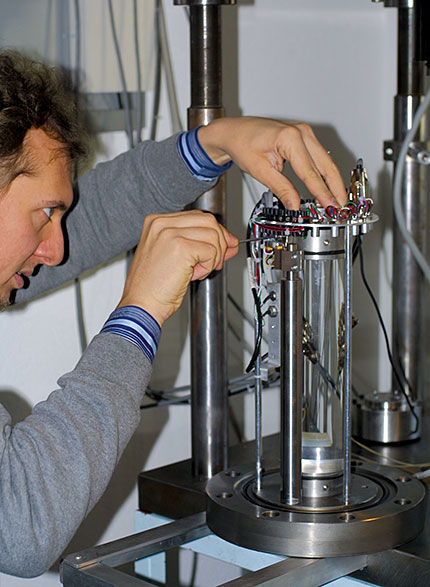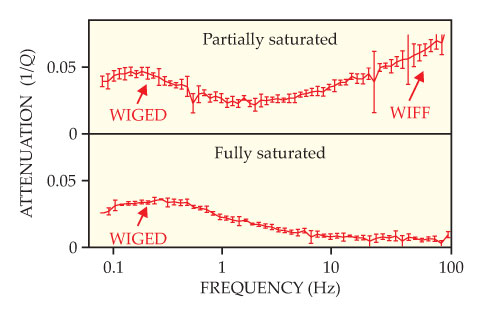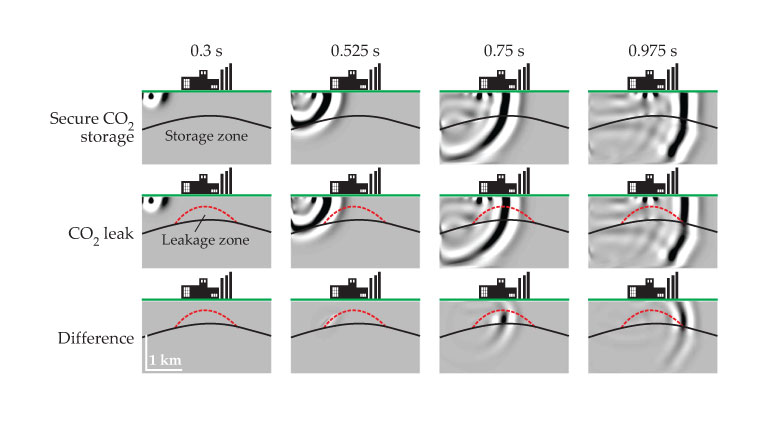Microscopic bubbles sap seismic waves’ strength
DOI: 10.1063/PT.3.2865
About 10 years ago, Jurgen Neuberg, a volcanologist at the University of Leeds, and his colleagues discovered a subtle oversight in the theory of seismic-wave propagation. 1 Their calculations indicated that seismic waves traveling through a bubbly liquid should attenuate more quickly than anyone had imagined. As their thinking went, the oscillating pressure field of a passing wave should continually shift the thermodynamic equilibrium between the bubble and liquid phases: As pressure rises, gas molecules should diffuse from the bubbles to the liquid, and vice versa as pressure falls. The cyclical contraction and expansion of the bubbles would dissipate substantial seismic energy as heat.
Neuberg and his coworkers were trying to answer a specific question: How far can seismic waves travel inside the magma-filled chutes of a volcano? But the potential implications of their finding were broad. Geophysicists typically image Earth’s upper crust by detecting reflections of seismic waves in the frequency window 0.1–100 Hz, where dissipation is assumed to be virtually negligible. (For more on seismic imaging, see the article by Roel Snieder and Kees Wapenaar, Physics Today, September 2010, page 44
For nearly a decade, the team’s theory remained just that, in large part because attenuation is difficult to disentangle from scattering, geometric spreading, and other phenomena that affect field measurements of seismic-wave amplitudes. Now Nicola Tisato (University of Toronto and ETH Zürich) and his colleagues have obtained evidence of bubble-induced attenuation in a lab experiment. 2 Their data suggest that the effect, which they’ve dubbed wave-induced gas exsolution–dissolution (WIGED), should be strong enough to detect in the field, provided one knows where to look for it.
The earthquake machine
Tisato originally set out looking not for WIGED but for a phenomenon known as wave-induced fluid flow (WIFF), a sloshing that can occur when a two-fluid system is subjected to seismic forcing. Theorists at the University of California, Berkeley, and at Stanford University showed in 2004 that WIFF could cause significant attenuation of high-frequency seismic waves inside fluid-filled porous rocks. 3
To study that attenuation in a controlled setting, Tisato and an ETH coworker built an earthquake machine—a plastic tube in which a cylindrical rock sample up to 250 mm long could be compressed to pressures comparable to those prevailing a couple of kilometers below Earth’s surface. 4 (Figure 1 shows Tisato working on the device.) A motor attached to one end of the tube generates pressure waves along the sample’s axis to mimic seismic activity, while a strain sensor monitors the sample’s resulting expansion and contraction.

Figure 1. Nicola Tisato tinkers with his earthquake machine, which can mimic seismic waves traveling kilometers below Earth’s surface. (Photo courtesy of Nicola Tisato.)

A perfectly elastic block would expand and contract in exact phase with the pressure wave, but a viscoelastic block—one that dissipates some mechanical energy—will respond with a slight phase delay. From the magnitude of that phase delay, one can infer the rate of energy dissipation and, in turn, the attenuation rate.
When Tisato and his fellow lab members loaded the device with a porous sandstone block infused partly with water and partly with air, they saw strong attenuation at frequencies of 100 Hz and higher, just as the WIFF theory predicts. But as they infused more water, they encountered a surprise. As Tisato explains, “The conventional wisdom was that as you approach 100% saturation—as you completely fill the pores with water—the attenuation should disappear. To get wave-induced flow you need at least two fluids having different flow properties.” But in the team’s experiments, attenuation never went away, even at full saturation. Rather, as shown in figure 2, a second attenuation peak emerged, this one at a lower frequency.

Figure 2. Attenuation spectra for pressure waves in a porous sandstone block saturated with gas-rich water. The value 1/Q represents the fractional decrease in amplitude per wavelength. A partially saturated block (top) exhibits high-frequency attenuation due to wave-induced fluid flow (WIFF) and a low-frequency attenuation peak due to wave-induced gas exsolution–dissolution (WIGED). A fully saturated block (bottom) exhibits only the WIGED peak. (Adapted from ref.

The researchers didn’t realize it at the time, but they had created conditions that were ripe for WIGED. The water they used was saturated with dissolved gas, such that even a slight drop in pressure spawned microbubbles. In their study, that pressure drop was an artifact of the experimental protocol, but the same scenario would be expected to play out in geological settings whenever a gas-rich liquid migrates from deeper to shallower zones in Earth’s crust.
Teaming up with Beatriz Quintal and Yury Podladchikov of the University of Lausanne, Tisato was eventually able to explain the low-frequency peak using a model inspired by Neuberg and company’s earlier work on volcanic chutes. Although the precise position of the WIGED peak varied depending on the particulars of the fluid properties, it always fell between 0.1 and 10 Hz, in the sweet spot for seismic imaging.
WIGED at work
To demonstrate one potential application of the new phenomenon, Tisato and his coworkers simulated a hypothetical scenario in which a carbon sequestration facility is monitored with seismic pulses. The team considered two cases—one in which dissolved carbon dioxide remains securely contained in a 1-km-deep storage zone and another in which it has leaked into the overlying sandstone, where it threatens to escape into the atmosphere.
The top row in figure 3 shows the evolution of a seismic pulse, emitted from a source at top left, in the secure-storage scenario; the middle row shows the evolution of the same pulse in the leak scenario; and the bottom row shows the difference between the two. In the leak scenario, WIGED attenuation in the CO2-rich portion of the sandstone layer diminishes the pulse’s amplitude by as much as 38%, an amount that should be easily detectable with seismic sensors.

Figure 3. A leak at a simulated carbon sequestration site is signaled by the anomalous attenuation of a seismic pulse. The top row shows the evolution of the pulse for the case in which dissolved carbon dioxide remains securely stored 1 km below ground; the middle row shows the same pulse in the case where CO2 has leaked and formed microbubbles in the overlying sandstone layer; and the bottom row shows the difference between the two. Due to bubble-induced attenuation, the energy of the seismic signal is, at certain locations, 38% smaller in the leak scenario than in the secure-storage scenario. (Adapted from ref.

Vernon Cormier of the University of Connecticut sees WIGED as a potential boon to the field of natural-resource recovery, in which seismic imaging is often used to identify the locations of oil and natural-gas reservoirs. “By incorporating attenuation into the imaging models,” says Cormier, “you might also be able to determine the percentage of dissolved gases, which could be useful both for economic and for climate- related reasons.”
The University of Aberdeen’s Luca De Siena is similarly optimistic, though he adds a caveat. “The potential impact of WIGED is huge, assuming it can be related to actual seismological data at field scale,” he says. “In my opinion, it likely can.”
References
1. L. Collier et al., J. Volcanol. Geotherm. Res. 153, 21 (2006). https://doi.org/10.1016/j.jvolgeores.2005.08.009
2. N. Tisato et al., Geophys. Res. Lett. 42, 3880 (2015). https://doi.org/10.1002/2015GL063538
3. S. R. Pride, J. G. Berryman, J. M. Harris, J. Geophys. Res. Solid Earth 109, B01201 (2004). https://doi.org/10.1029/2003JB002639
4. N. Tisato, C. Madonna, J. Appl. Geophys. 86, 44 (2012).https://doi.org/10.1016/j.jappgeo.2012.07.008
